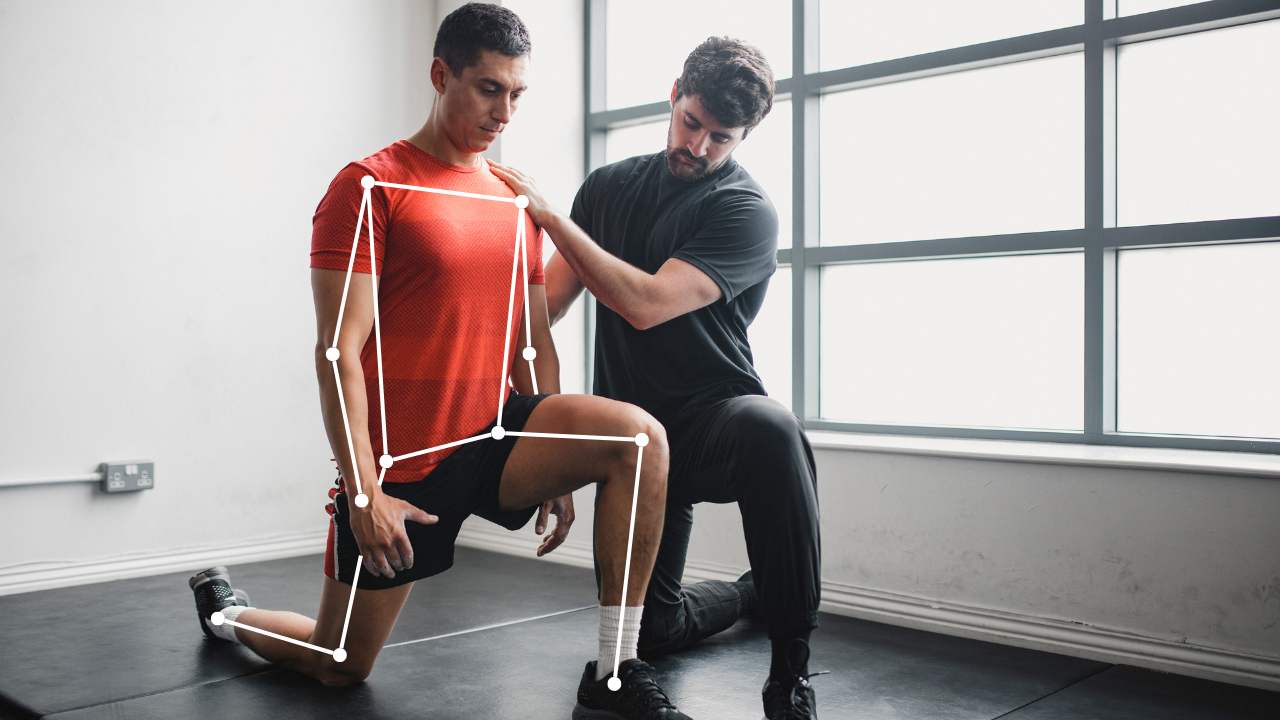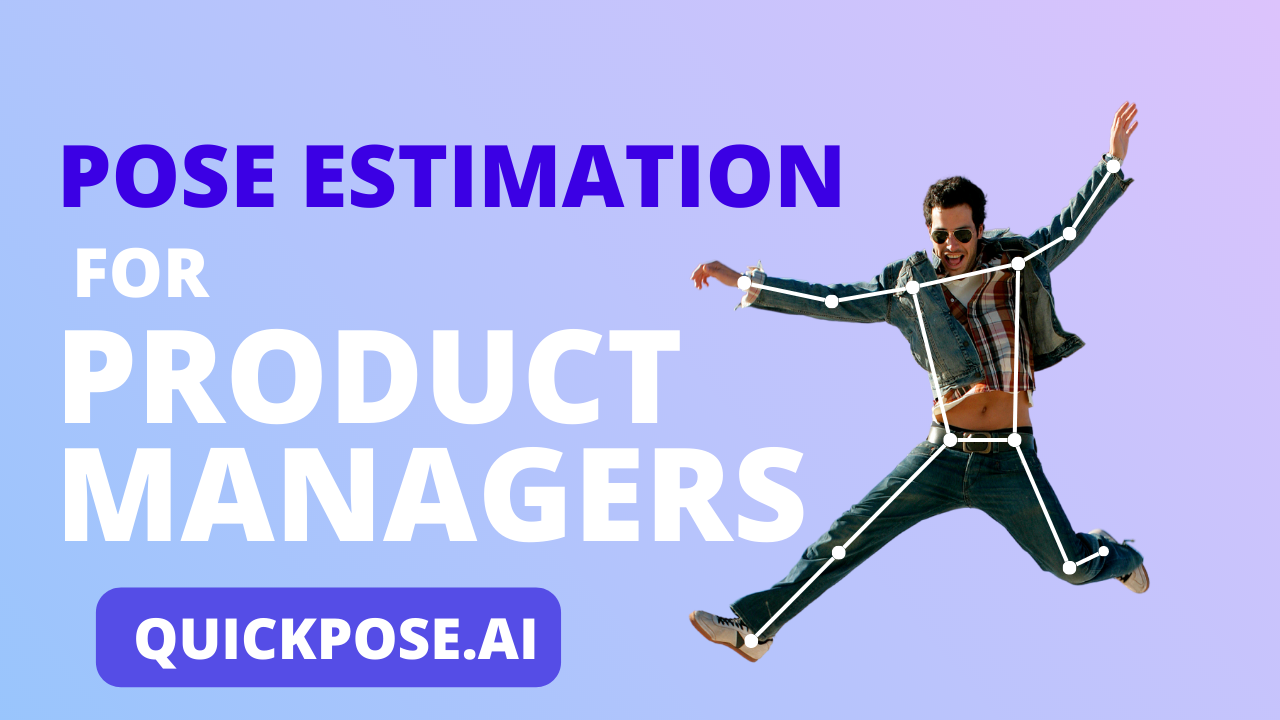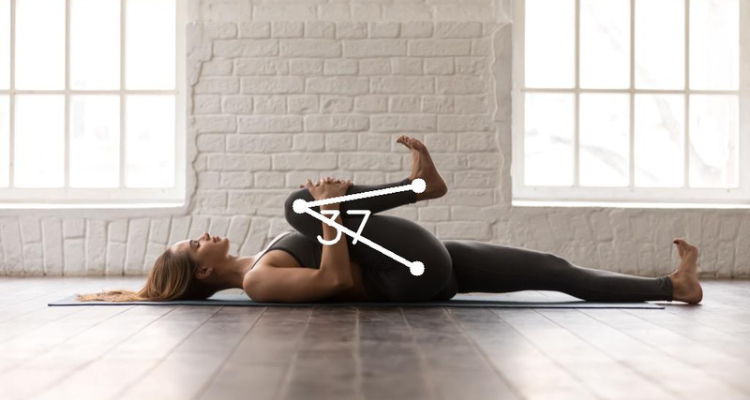Human Pose Estimation is a computer vision technique that utilizes Machine Learning (ML) and Deep Learning (DL) to detect, identify, and track human body poses. It is an important technology that has opened up possibilities in a variety of industries and applications. If you are a Product Manager, Entrepreneur, of Software Developer searching for “What is Human Pose Estimation?”, you have come to the right place. Read on to learn how Human Pose Estimation is now more accessible for your apps.
About us: at QuickPose.ai, we are passionate about movement through tech. We develop pose estimation products across industries and platforms.
Using just the camera in a smartphone, apps can use Human Pose Estimation to create more engaging experiences.
Human Pose estimation uses machine learning algorithms to plot key points of the human body on an image or video (which is made up of multiple images). We call these key points “Landmarks”.
Apps then interpret these Human Pose Estimation Landmarks to create unique use cases, such as:
- Identifying Poses using pose classifiers, for example a Fitness app counting reps of an exercises
- Measuring angles between joints, for example a health app measuring range of motion for injury recovery
- As a game controller, for example identifying the body’s position to control up, down, left, and right directions through movement, rather than a games controller
Get Access to Our TestFlight Demo
Check out QuickPose iOS SDK abilities in our TestFlight Demo app.
How are Machine Learning and Deep Learning used in Human Pose Estimation?
Human Pose Estimation uses Machine Learning and Deep Learning to detect and track body poses. Machine Learning algorithms are employed to create models that can recognize various poses from a set of images or videos. Deep Learning is then used to further refine the recognition process by allowing for more detailed recognition of specific body parts, such as hands, arms, legs, and other body parts.
In addition to recognizing poses, Machine Learning and Deep Learning can also be used to create 3D models of people in real-time. This is done by analyzing the position of the human body and then rendering a 3D model for further manipulation.
The Benefits of Using Human Pose Estimation
Human pose estimation is a powerful technology that offers numerous benefits in various industries, from healthcare to entertainment. We will explore the benefits human pose estimation, including improved rehabilitation outcomes, enhanced athletic performance, and more immersive gaming experiences.
Improved user experience:
Human pose estimation can be used to track and respond to the movements of a user, allowing for a more interactive and engaging experience.
Enhanced virtual reality:
In virtual reality applications, human pose estimation can be used to track the user’s body movements and translate them into actions within the virtual environment. This can improve the realism and immersion of the VR experience.
Improved image and video processing:
Human pose estimation can be used to extract information about the poses of people in images and videos. This can be used for a variety of purposes, such as automatically cropping and framing pictures or generating stylized videos.
Enhanced security and surveillance:
Human pose estimation can be used in security and surveillance systems to track the movements of individuals and detect suspicious behaviour.
Improved sports analysis:
In sports, human pose estimation can be used to track the movements of athletes and analyze their performance, which can be useful for coaching and training purposes.
Enhanced health and fitness applications:
Human pose estimation can be used in health and fitness applications to track and analyze the movements of users. hich can be helpful for developing personalized exercise plans and monitoring progress.
Challenges Faced in Implementing Human Pose Estimation in a Health or Fitness App
For too long, Entrepreneurs and Software Developers faced expensive and technical challenges when implementing Human Pose Estimation into their products. These challenges prevented great ideas from being built, however, at QuickPose, we overcame these challenges so you only need a few lines of code to install our SDK.
Time-consuming for developers
Implementing human pose estimation into an app can be a time-consuming process for developers due to several factors. One reason is that it can be challenging to design and implement algorithms that are able to accurately track and estimate the poses of people in real-time. This may require significant research and development efforts, as well as the use of sophisticated machine learning techniques.
Additionally, the implementation of human pose estimation often requires the collection and annotation of large amounts of data in order to train the algorithms. This can be a time-consuming process, as it may involve manual labeling of data by humans.
Furthermore, testing and debugging the pose estimation algorithms can also be time-consuming, as developers may need to iterate and fine-tune the algorithms in order to achieve satisfactory performance.
Finally, integrating the pose estimation functionality into the overall app architecture and user interface can also be time-consuming, as it may require careful design and planning in order to provide a seamless and intuitive user experience.
Poor accuracy:
Human Pose Estimation systems are not always 100% accurate due to the complexity of the human body, which can make it difficult for algorithms to accurately detect and track poses.
Complexity of training data:
Training a Human Pose Estimation system requires large amounts of data which can be difficult to generate or acquire.
High computational power requirements:
Human Pose Estimation systems require a lot of computational power to run, which can be expensive and time-consuming.
Privacy concerns:
Human Pose Estimation systems can collect sensitive data about individuals, which raises privacy issues that must be addressed before deploying the system in a health or fitness application.
Tips for Optimizing Performance with Human Pose Estimation
Use efficient algorithms:
There are many different algorithms available for human pose estimation, and some may be more efficient than others in terms of computational requirements and runtime. Carefully selecting and optimizing algorithms can help to improve performance.
Use the right data:
Training and evaluating pose estimation algorithms on appropriate and relevant data can help to improve their performance.
Optimize code and algorithms:
Carefully optimizing the code and algorithms used for pose estimation can help to reduce computational requirements and improve runtime.
Use parallel processing:
Depending on the hardware available, using techniques such as parallel processing can help to improve the performance of pose estimation algorithms.
Reduce data size:
Reducing the size of the data being processed can help to reduce computational requirements and improve runtime.
Optimize parameters:
Tuning parameters such as learning rate and regularization parameters can be critical for achieving better performance.
Pre-process and augment data:
Pre-processing, such as image cropping or normalization, and data augmentation, such as rotations or scaling, can help improve accuracy and reduce computational costs. In some cases, using lightweight models with fewer parameters may be more efficient and result in better performance than larger and more complex models.
Apply techniques like transfer learning:
Transfer learning can help improve performance by using a model pre-trained on a related task.
Test and evaluate the system:
Adequate testing and evaluation of the system is necessary in order to identify any potential issues or areas for improvement.
Analyze errors:
Analyzing errors can provide insight into how to improve accuracy and performance.
Monitor infrastructure:
Monitoring the system’s infrastructure, such as network bandwidth and latency, can help optimize performance in real-world applications.
Future Directions for Research and Development in the Field of Human Pose Estimation
As the field of Human Pose Estimation continues to advance, there are several areas where further research and development is needed. These include:
Improving accuracy and precision:
Current methods are not yet accurate enough for applications in real-world scenarios, such as medical or safety-critical tasks. Developing new algorithms that can accurately detect and track poses in complex scenarios is an area of active research.
Increasing speed and efficiency:
Current methods are too slow for use in real-time applications. Developing new algorithms that can process data quickly with minimal computational requirements is another area of active research.
Improving robustness to environmental differences:
Different environments, such as lighting or background, can cause current methods to fail. Developing new algorithms that can handle complex and variable conditions is an area of active research.
Integrating with other technologies
Pose estimation could be used in combination with other technologies, such as augmented reality, for more immersive applications. Developing methods for integrating pose estimation with other technologies is an area of active research.
Utilizing data from multiple sources:
Combining data from different sources, such as video and motion capture sensors, can potentially lead to more accurate pose estimation results. Developing algorithms that can effectively use multiple kinds of data is an area of active research.
Enhancing privacy features:
Pose estimation could be used in applications where user privacy must be protected. Developing methods for protecting the privacy of users when using pose estimation technology is an area of active research.
Developing new applications:
Researchers are constantly seeking out new and innovative ways to apply human pose estimation in a variety of domains, including health and fitness, sports, entertainment, and security.
Exploring new machine learning techniques:
Researchers are investigating the use of new machine learning techniques, such as deep learning and reinforcement learning, for pose estimation and other computer vision tasks.
Overall, there are many exciting opportunities for further research and development in the field of Human Pose Estimation. With continued progress, these advances could ultimately open up new possibilities for a broad range of applications.
How to get Human Pose Estimation into your App with QuickPose iOS SDK
The QuickPose iOS SDK allows developers and product managers to quickly integrate pose estimation into their apps with minimal effort. As researchers continue to explore new machine learning techniques like deep learning and reinforcement learning for use in computer vision tasks such as pose estimation, products like QuickPose.ai will become increasingly powerful tools that can help transform existing applications or create entirely new ones.
Developing applications that use human pose estimation can be a time-consuming and difficult process. You want to create an application that leverages the power of human poses, but don’t have the time or resources to develop your own algorithms.
The QuickPose iOS SDK elevates the skills of developers to create applications that use Human Pose Estimation. With QuickPose, developers can quickly and easily implement robust, accurate human pose estimation into their applications — enabling new possibilities for a wide range of industries.
As the field continues to evolve, developers will have access to more powerful tools for building creative applications with Human Pose Estimation at their core. With the right technology, developers can unlock the potential of Human Pose Estimation in a variety of novel ways.
At QuickPose, we are excited about the future of Human Pose Estimation and what it can do for our customers’ projects. We look forward to continuing to be a part of this revolutionary journey and helping fuel innovation in the space. We can’t wait to see what you build.
How to partner with QuickPose to get Pose Estimation into your App
At QuickPose, we develop cutting edge Pose Estimation solutions for our clients. The people who use our services include Fitness Apps, Physiotherapy apps, and sports equipment companies. Please feel free to book a call with us here.
To explore ways that AI can enhance your product or service, please request a free AI Review.
Get Access to Our TestFlight Demo
Check out QuickPose iOS SDK abilities in our TestFlight Demo app.



